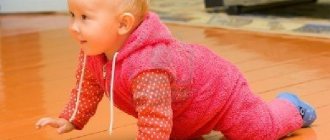The first year of a baby’s life is perhaps the most important and most difficult. The child changes literally before our eyes. In the first 12 months, he “transforms” from a small, helpless baby into an active, cheerful baby. It is certainly not easy for him to learn new skills, and he really needs support and sometimes help from his parents. So your baby has learned to hold his head up, roll over onto his tummy and back again, and you can't wait for him to start crawling? After all, with the acquisition of this skill, your baby will turn into an active explorer of the outside world.
When is it time to crawl?
According to scientific research, a fully developing child begins to crawl at six to seven months, sometimes a little later. However, some babies skip this stage of development. His parents believe that crawling is not necessary and are teaching him to use a walker. They assume that this way he will develop faster intellectually and physically. As a result, the baby begins to walk, bypassing the crawling stage. In addition, parents get used to the fact that the child should sleep on his back and during wakefulness they forget to turn him over onto his tummy.
As a result, he gets used to this position; when he turns over on his stomach, he begins to act up, and his mother returns him to his usual position. The muscles of the limbs, which should gradually become stronger, remain without training. And by the due date, at best, the child begins to crawl back or does not do this at all.
Opinion of Dr. Komarovsky and B. Spock
It is quite difficult to say exactly at what month your baby will start crawling. However, if he knows how to roll over and likes it, he will soon try to move around. B. Spock claims that babies begin to learn this process at five or six months, and crawl quite well by seven months. At the same time, they have different ways of crawling. In some families, already at four or five months the child is crawling backwards, in others - immediately on all fours, but this happens later, at seven or eight months. Nevertheless, both are considered the norm.
Pediatrician E. Komarovsky believes that the child himself knows and decides when to sit, crawl and walk. And parents should not interfere with this; it is their duty to ensure that these processes bring joy to the child and are not hard work.
The formation of a child’s motor activity is influenced by:
- psychological atmosphere in the family;
- personal and physical characteristics of the baby;
- his state of health.
In other words, crawling is a certain stage of development that some babies skip and go straight to walking. However, this is also a variant of the norm.
At what months does a baby begin to crawl?
All parents are looking forward to the moment when their baby, even if only on his knees, begins to move independently. Crawling is a very important skill for a child; with its help, the spine is strengthened, micro- and macromotor skills are developed, and coordination of movements is significantly improved. By crawling, the baby learns to control his body.
Many parents are sure that at 6 months the baby should master two skills - learn to sit and crawl. Once again, I would like to note that each child is individual, and therefore has his own development schedule. Some children who have mastered the skill of sitting simply do not want to crawl. And having “jumped over” this stage, they immediately move on to mastering the skill of walking. It’s interesting, but some babies, having learned to walk, suddenly begin to crawl. Therefore, if your baby does not want to crawl, but is trying to immediately take his first steps, there is no need to worry. Apparently, he chose a different development schedule.
When should a child normally learn to crawl?
Children under one year old master the skill of crawling from 6 to 9 months. If the baby began to crawl earlier, this indicates his activity and positive heredity.
If, in trying to answer this question, we turn to medical statistics, then we can say that most children begin to crawl confidently at 8 months. But these are just average statistics.
Several opinions of famous doctors about how many months a child should learn to crawl:
- Benjamin Spock believed that infants should learn this skill between 5 and 6 months.
— Pediatrician Komarovsky clearly states that this question is incorrect, since there are no exact age criteria for mastering this skill.
If your baby is already 9 months old, and he doesn’t even try to crawl or try to get up, there is a reason to seek advice from a neurologist.
Do you need to learn to crawl?
You should not force the baby to lie on his stomach, but gradually it is necessary to accustom him, preparing him for crawling. After all, this is a very important period not only for physical development, but for the subcortical structures of the brain. In particular, brain dysfunction, which is a consequence of difficult childbirth or birth trauma, is compensated to some extent during the crawling period. During this activity, the baby strengthens the musculoskeletal system, trains the arms, shoulders, elbows and wrists. Therefore, crawling children are more physically developed than infants who missed this stage. Training the ligaments of the wrists and hands is useful for the development of fine motor skills.
Such kids will quickly learn to hold a spoon and pencil correctly. In addition, while crawling, the child learns to navigate in space and control the body. Therefore, the crawling stage is useful and important and should be encouraged and supported. If your heir independently chose his crawling style, then it is better not to interfere with him, advises pediatrician E. Komarovsky. Whether the child crawls backwards or using one leg - it doesn’t matter, he is fulfilling his individual development program. During this process, the baby develops his first spatial orientation skills.
A child does not crawl at 8 months: reasons, should all children be able to crawl?
Crawling is an important stage in a baby's development. This skill prepares him for walking by strengthening his muscles. Crawling is a skill that helps:
- Strengthening the muscles of the back, arms and legs.
- Development of the musculoskeletal system.
- Improving psychomotor development.
- Proper development of the central nervous system (CNS) and brain.
Expert opinions: is it necessary for a baby to first learn to crawl and then walk?
Children's specialists disagree on whether infants should master this skill. Some argue that if a baby at the age of eight months has not learned to crawl, there is nothing to worry about. He simply belongs to the group of “non-crawling” children. Such children first learn to walk, and only then crawl. Other doctors recommend that parents whose baby is not crawling at eight months visit an orthopedist and neurologist. Parents should know that premature babies begin to crawl at ten to eleven months. For them this is considered the norm.
Many neurologists agree that crawling has a very beneficial effect on the development of the nervous system and its absence can have a negative impact in the future. Crawling children begin to speak earlier; as a rule, they do not have speech therapy problems.
The reluctance of a baby to crawl can be caused by the following reasons:
- The child has health problems .
- The baby is constantly in a confined space (in a playpen, in a crib).
- Features of the child's temperament . Some children prefer to watch what is happening and do not show much interest in mastering this skill. Information in another article on our website will help you determine the temperament of a child up to one year old and older.
- Overweight . It is difficult for obese children to crawl.
Recently, early childhood development has become fashionable all over the world. Restless parents, from the cradle, begin to teach their children to speak, read, sing and dance at the same time. They proudly declare that their child did not even try to crawl, he immediately walked. But is it really that good? Parents should realize that it is during crawling that the baby develops the first spatial orientation skills. Put in a little effort and your baby will definitely master this skill.
Why does the baby crawl backwards?
He can do this:
- Consciously. For example, I saw my mother mopping the floors and moving backwards, or I spied on older children playing.
- Forced - he tried to crawl forward, but his arms turned out to be weak, he fell and hit himself.
- Intuitively, the child’s body understands that some muscles need to be protected, while others can be relied upon. Crawling backwards, the baby spends less energy.
According to pediatricians, this is not dangerous and the baby does not have any pathology. However, if the baby does not attempt to crawl forward after two or three months, then it is recommended to evaluate his muscle strength. In some cases, the reason lies in muscle hypertonicity or hypotonicity.
So, if a baby crawls backwards for a long time, then corrective gymnastics is necessary, since moving in one direction does not allow all muscle groups to develop.
The child crawls backwards: causes, development standards, doctor’s recommendations
Every mother closely monitors the development of her baby. In a child’s life, everything most often happens in stages, but sometimes he skips one of them and moves on to the next one. In this case, the parents are proud of their child. And if a child crawls backwards, should we worry and retrain him? We will talk about this in the article.
When is it time to crawl?
According to scientific research, a fully developing child begins to crawl at six to seven months, sometimes a little later. However, some babies skip this stage of development. His parents believe that crawling is not necessary and are teaching him to use a walker.
They assume that this way he will develop faster intellectually and physically. As a result, the baby begins to walk, bypassing the crawling stage. In addition, parents get used to the fact that the child should sleep on his back and during wakefulness they forget to turn him over onto his tummy.
As a result, he gets used to this position; when he turns over on his stomach, he begins to act up, and his mother returns him to his usual position. The muscles of the limbs, which should gradually become stronger, remain without training. And by the due date, at best, the child begins to crawl back or does not do this at all.
Opinion of Dr. Komarovsky and B. Spock
It is quite difficult to say exactly at what month your baby will start crawling. However, if he knows how to roll over and likes it, he will soon try to move around. B.
Spock claims that babies begin to learn this process at five or six months, and crawl quite well by seven months. At the same time, they have different ways of crawling.
In some families, already at four or five months the child is crawling backwards, in others - immediately on all fours, but this happens later, at seven or eight months. Nevertheless, both are considered the norm.
Pediatrician E. Komarovsky believes that the child himself knows and decides when to sit, crawl and walk. And parents should not interfere with this; it is their duty to ensure that these processes bring joy to the child and are not hard work.
The formation of a child’s motor activity is influenced by:
- psychological atmosphere in the family;
- personal and physical characteristics of the baby;
- his state of health.
In other words, crawling is a certain stage of development that some babies skip and go straight to walking. However, this is also a variant of the norm.
Do you need to learn to crawl?
You should not force the baby to lie on his stomach, but gradually it is necessary to accustom him, preparing him for crawling. After all, this is a very important period not only for physical development, but for the subcortical structures of the brain.
In particular, brain dysfunction, which is a consequence of difficult childbirth or birth trauma, is compensated to some extent during the crawling period. During this activity, the baby strengthens the musculoskeletal system, trains the arms, shoulders, elbows and wrists.
Therefore, crawling children are more physically developed than infants who missed this stage. Training the ligaments of the wrists and hands is useful for the development of fine motor skills.
Such kids will quickly learn to hold a spoon and pencil correctly. In addition, while crawling, the child learns to navigate in space and control the body. Therefore, the crawling stage is useful and important and should be encouraged and supported.
If your heir independently chose his crawling style, then it is better not to interfere with him, advises pediatrician E. Komarovsky. Whether the child crawls backwards or using one leg - it doesn’t matter, he is fulfilling his individual development program.
During this process, the baby develops his first spatial orientation skills.
Why doesn't the baby crawl?
Often children bypass this phase and immediately begin to walk, since the physiological development of each baby is individual. Here are some reasons why babies do not want or cannot crawl either forward or backward:
- injuries;
- weak muscles;
- using a walker for a long period (more than sixty minutes);
- excess body weight;
- consequences of rickets;
- forced immobilization of limbs;
- baby's temperament.
Why does the baby crawl backwards?
He can do this:
- Consciously. For example, I saw my mother mopping the floors and moving backwards, or I spied on older children playing.
- Forced - he tried to crawl forward, but his arms turned out to be weak, he fell and hit himself.
- Intuitively, the child’s body understands that some muscles need to be protected, while others can be relied upon. Crawling backwards, the baby spends less energy.
According to pediatricians, this is not dangerous and the baby does not have any pathology. However, if the baby does not attempt to crawl forward after two or three months, then it is recommended to evaluate his muscle strength. In some cases, the reason lies in muscle hypertonicity or hypotonicity.
So, if a baby crawls backwards for a long time, then corrective gymnastics is necessary, since moving in one direction does not allow all muscle groups to develop.
The child began to crawl backwards: pros
Let's look at the positive aspects of this skill:
- The increase in muscle load occurs gradually. Moving around thanks to the push is quite easy. The development of joints and the development of the vertebral sections occurs without any unpleasant sensations for the baby.
- It turns out that teaching a baby to crawl backward is more difficult than teaching it to crawl forward. In addition, during this movement, muscle groups work that are not involved when moving forward.
- According to scientists, with this method of movement the vestibular apparatus is trained.
Learn to crawl correctly
The child crawls backwards, but how to teach him forwards and is it possible to do this? First of all, you need to be patient. It takes a certain amount of time for a child to learn a new skill. The following recommendations will help you cope on your own:
- It is necessary to evaluate the quality of the surface on which the child moves. The surface should be pleasant and not slippery.
- Place his favorite toy in front of him and let him reach for it. However, you should not help him in this case.
- Encourage and praise your baby when he crawls correctly.
- Show by example how to move.
The most important thing is that the baby has fun and interesting learning to crawl forward, and this requires devoting a lot of time to such activities.
Russian medical standards
In accordance with these standards, the baby must master the technique of crawling at six to seven months, i.e. during this period he tries to make his first movements. This stage is preceded by the ability to roll over onto your tummy and hold your head up.
Initially, the baby tries to crawl on his tummy, since he does not yet know how to move his legs. The entire load falls on the muscular system of the upper limbs.
Then he begins to understand that he can also use his legs - push off with them or pull up.
During this period, some babies begin to crawl in different ways. After a short period of time, the little one already feels confident and moves freely.
Sometimes he does it backwards, and worried mothers ask doctors what to do if the baby crawls backwards? Most children will begin to crawl in the right direction after some time and no further action is required.
In case of hypo- or hypertonicity, special gymnastics will help, with the help of which the muscles are strengthened.
Importance and benefits of baby crawling
Crawling develops a sense of equilibrium, balance, and strength. In addition, this important stage forms and strengthens the baby’s emotional, visual understanding, and motor skills. So, thanks to crawling:
- Motor skills and the ability to make small and precise movements appear. When crawling, all muscle groups work, motor-visual coordination is developed, and the ability to control the small muscles of the body is established.
- The spine is fixed and aligned. When a baby begins to crawl, he not only learns to control his limbs, but also develops a muscular system that strengthens the spinal column.
- Visual perception, brain, and vestibular apparatus develop. While crawling, the toddler uses binocular vision, as a result he develops a reaction that will be useful in the future for reading and writing skills. During such movement, the vestibular apparatus also develops, helping to improve balance. When crawling, motor nerve impulses switch places between the two hemispheres at tremendous speed. This promotes the development of neurological skills.
If a child crawls backwards, it means it’s comfortable for him. He is trying to master his body and coordinate his movements. Of course, not everything will work out right away, but there is no need to panic. This phenomenon is not considered a deviation from the norm. All kids are different. Let your baby develop individually and delight you every day with new small achievements that bring him joy and delight.
Source: https://FB.ru/article/461430/rebenok-polzaet-nazad-prichinyi-normyi-razvitiya-rekomendatsii-vrachey
The child began to crawl backwards: pros
Let's look at the positive aspects of this skill:
- The increase in muscle load occurs gradually. Moving around thanks to the push is quite easy. The development of joints and the development of the vertebral sections occurs without any unpleasant sensations for the baby.
- It turns out that teaching a baby to crawl backward is more difficult than teaching it to crawl forward. In addition, during this movement, muscle groups work that are not involved when moving forward.
- According to scientists, with this method of movement the vestibular apparatus is trained.
Why do some babies crawl backwards?
As a rule, babies begin to crawl on their tummy. But even so, many of them prefer to choose their own mode of transportation. Some kids move backwards or sideways. The second stage of mastering this skill consists of trying to push the arms forward and pulling both legs. Only after this do infants switch to cross crawling on all fours.
Why does the baby crawl backwards?
Some parents, watching their child, notice that the baby is already crawling quite quickly, but is only moving backwards. And they begin to retrain him. However, there is no need to rush into this. Experts believe that the baby subconsciously understands which muscles are best used when moving and which ones should be spared. Among other things, this method of movement has its advantages:
- The load on the muscles increases gradually.
- All parts of the spine develop in a gentle manner.
- Crawling backwards trains the vestibular system.
Over time, the baby must change the direction of movement himself.
However, if after a couple of months the baby still crawls only backwards, parents should be wary and consult with specialists. Perhaps the baby has problems with muscle tone. So, if your baby is persistently crawling backwards at six or seven months, there is no reason to worry. But if nothing has changed in nine to ten months, you may have to introduce special corrective exercises into his regime.
Learn to crawl correctly
The child crawls backwards, but how to teach him forwards and is it possible to do this? First of all, you need to be patient. It takes a certain amount of time for a child to learn a new skill. The following recommendations will help you cope on your own:
- It is necessary to evaluate the quality of the surface on which the child moves. The surface should be pleasant and not slippery.
- Place his favorite toy in front of him and let him reach for it. However, you should not help him in this case.
- Encourage and praise your baby when he crawls correctly.
- Show by example how to move.
The most important thing is that the baby has fun and interesting learning to crawl forward, and this requires devoting a lot of time to such activities.
Should you be afraid of your baby crawling backwards?
Why a child does not crawl at 9 months - reasons
Not all kids develop according to the textbook; you should take this as a given and not worry too much. Some babies are even born not quite standardly - feet first, and nothing, they grow up like all normal children. Therefore, if the baby crawls in the wrong direction, the mother has two options: accept it and do nothing; and try to teach the child to crawl forward.
Russian medical standards
In accordance with these standards, the baby must master the technique of crawling at six to seven months, i.e. during this period he tries to make his first movements. This stage is preceded by the ability to roll over onto your tummy and hold your head up. Initially, the baby tries to crawl on his tummy, since he does not yet know how to move his legs. The entire load falls on the muscular system of the upper limbs. Then he begins to understand that he can also use his legs - push off with them or pull up.
During this period, some babies begin to crawl in different ways. After a short period of time, the little one already feels confident and moves freely. Sometimes he does it backwards, and worried mothers ask doctors what to do if the baby crawls backwards? Most children will begin to crawl in the right direction after some time and no further action is required. In case of hypo- or hypertonicity, special gymnastics will help, with the help of which the muscles are strengthened.
Importance and benefits of baby crawling
Crawling develops a sense of equilibrium, balance, and strength. In addition, this important stage forms and strengthens the baby’s emotional, visual understanding, and motor skills. So, thanks to crawling:
- Motor skills and the ability to make small and precise movements appear. When crawling, all muscle groups work, motor-visual coordination is developed, and the ability to control the small muscles of the body is established.
- The spine is fixed and aligned. When a baby begins to crawl, he not only learns to control his limbs, but also develops a muscular system that strengthens the spinal column.
Why does my baby only crawl backwards?
Any mother closely monitors the developmental characteristics of her baby. From the birth of a child until the moment when he begins to walk confidently, the toddler goes through several stages: he learns to roll over, hold his head up, sit down, crawl, and stand up.
Moreover, this “evolution” can occur either gradually or in jerks, when a little person “jumps over” some steps.
It happens that some developmental features of a fidget worry the mother. For example, a child crawls backwards rather than forwards. Should we sound the alarm? Is this normal? Is it possible to somehow help the baby, teach him to crawl correctly?
There's really nothing wrong with that. If your child crawls, that’s already good. Today, many children bypass this stage and immediately begin to walk unsteadily.
Some mothers are proud of such an “achievement,” they say, my child is developing ahead of his peers. Such a jerk is not considered a deviation from the norm, but, nevertheless, pediatricians believe that first the baby must still learn to move with the help of arms and legs, and only then master walking.
From this article you will learn
How to fix his crawling behavior
Why does a 6-9 month old baby constantly yell and be capricious?
If the mother really wants the baby to crawl as expected, then you can try to use several techniques for this.
You can try to lure your child with his favorite toy. To do this, you need to sit in front of him and place the toy at a distance that will not allow him to just grab the toy. There is no point in helping your child in this matter; sooner or later he will get his bearings and crawl forward.
You can try the same trick, but without a toy, just sit opposite and start calling your baby so that he reaches out to your hands. The main thing at this moment is to prevent resentment and hysteria.
Why crawling is so important for babies
Man is an upright creature, and walking upright on two limbs is not so easy. To do this, the little man must have developed muscles.
And it is the crawling stage that allows him to strengthen his body and prepare it for further achievements in the form of the first steps. Crawling, the baby strengthens the muscles of the arms, shoulders, and wrists. His musculoskeletal system becomes toned and prepares to withstand the load.
Additional bonus: development of fine motor skills.
While crawling, the little explorer stretches the ligaments in his wrists and hands. In the future, this will help him handle a spoon more easily and quickly master writing and drawing skills.
Therefore, pediatricians advise not to limit the child’s crawling. This is his natural desire to explore the new world and understand his body. Many parents strive to protect their offspring from the dangers of our world.
Moving on all fours, the baby can hit pieces of furniture or pull off something that is not intended for children's playful hands. Of course, it’s easier to place a fidget in a walker.
He is safe there, and he will learn to walk faster. In fact, in this way you are depriving the child of an important stage of his development. Crawling is useful and interesting, even if this process requires parents to pay closer attention to their child.
Is my baby crawling correctly?
According to Russian medical standards, a child should start trying to crawl at 6-7 months. This cannot be called full-fledged movement; the baby makes its first hesitant movements.
But this stage is preceded by turning over on the tummy and honing the ability to hold the head. Naturally, the sooner the baby learns to hold his head up, the faster he will want to learn to move.
The process can be divided into several stages:
- Crawling on your stomach. The baby resembles a small worm; he is trying very hard to move his body forward, but does not yet know how to do it.
He still doesn’t know how to use his legs; he moves only with his arms, so the entire load falls on the muscles of his arms.
- Intermediate stage: the baby understands that the legs can also be used. The child rests on his hands and knees, he learns to pull up his legs. It is at this time that some toddlers begin to behave atypically: crawling backwards, dragging their legs, etc.
- Stage of confident movement: the baby crawls briskly, all its movements are distinguished by clarity and coherence.
Why does a child prefer to crawl backwards? There may be several reasons. Firstly, for a baby there is no concept of “normality”. He believes that he is doing everything right. And you should adopt his confidence: your child’s development takes its own course, and it does not necessarily have to happen the same way as other children.
Secondly, moving backwards is easier for some babies, since their muscles are still weak. In this case, you can help your fidget strengthen the muscles for “correct” movement and show him that crawling forward is no less interesting.
But even if you do nothing, over time the child will learn to crawl in the right direction.
How to quickly teach a child to crawl on all fours: a set of exercises
Many pediatricians believe that a child can master this skill on his own. All parents must do is provide a favorable environment for their child. However, orthopedists and neurologists clearly speak about the benefits of crawling and recommend that parents (if necessary) use a specially designed set of exercises to help their children master the skill of crawling. But more on that later. First, let's define the concept of “favorable environment”.
- According to pediatricians, from the age of three months the baby should be given some freedom. Namely, at this age it needs to be placed on a special developmental mat. If you haven’t purchased such a mat, it’s okay, lay your baby on his tummy on the floor. Are you surprised? Don’t be surprised, American pediatricians call ordinary flooring “an athletic gym for babies.” Of course, the floor should first be covered with a warm rug or blanket; it should be clean, level and, of course, safe. Don't forget about comfortable clothes either. It should not hinder the baby's movements.
- Do not leave your child in the playpen for a long time . The arena is a closed space that, one way or another, limits the desire for movement. TO
- It is necessary to give the baby some motivation to move . To do this, you can put a bright toy so that he cannot reach it.
A favorable environment for crawling has been created, but the child still makes no attempt. What to do? There are two options: either wait or take action. Most parents prefer the second option. For them, we will give several effective exercises that will help the child quickly learn a new skill.
How to teach a child to crawl: effective exercises
Exercise to strengthen the vestibular system
Place the baby with his tummy on the carpet and his chest on the cushion. In this case, the legs and tummy should lie on a hard surface. In this position, the child can turn his head in different directions. Place toys next to the baby on both sides so that he can reach them with his hands. This exercise will teach you to maintain balance and strengthen the baby’s vestibular apparatus.
Exercise to strengthen muscles
We place the baby in the crib on his tummy. We hang a toy above his head. The child, raising himself on one arm, will try to reach the toy. To master the skill of crawling, a child must learn to lean on his hands when moving. This exercise will teach him not only to lean on his hands, but also strengthen his arm muscles.
Exercise to master a new pose
We place a small pillow or a specially made cushion under the baby's chest and belly. The child must learn to stand on all fours, and for this he needs to be shown this position. You can rock the baby a little on the roller so that he rests on his legs and then on his arms.
Exercise to strengthen the muscles of the back and abdomen
To practice, you will need a fitball (a large elastic ball). Place the baby's tummy on the ball and gently rock it.
Exercise "Frog"
The child should lie on a hard surface on his stomach. Mom grabs his legs by the shin and gently bends and straightens them. After performing this movement several times, it is necessary to hold the baby’s legs in a bent position. He will try to push himself away.
Exercise - three of us crawl
This exercise involves two adults. One will move the child’s arms one by one, the second will move the legs. So, the first one moves the child's right hand forward. The second moves the left leg, etc. This exercise teaches the child the basics of cross crawling.
As practice shows, babies, like monkeys, love to repeat the movements that another child makes. Invite a baby who has already learned to crawl well. Believe me, it won’t even take a couple of hours for your baby to master this skill. Of course, if he is already 6 months old.







